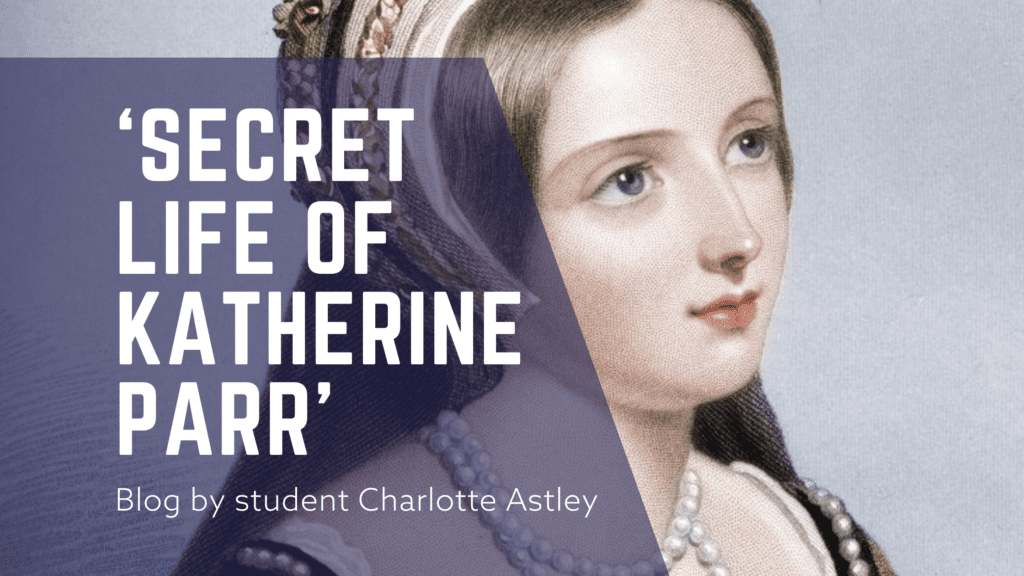By student Charlotte Astley – as featured in Making History
Divorced, beheaded, died, divorced, beheaded, survived. In this article we delve into the interesting life of Henry VIII’s sixth and final wife.
There is much debate over the exact spelling of her name, be it Catherine, Katherine or even Kateryn, however, as it is the most common way, for all purposes of this article, she will be referred to as Katherine.
Katherine’s early life:
Katherine was born around August 1512, allegedly named after Catherine of Aragon, which was ironic considering her own later marriage to King Henry VIII.
She had two siblings, Anne and William. Tragically, Katherine’s father died when she was only young.
This left Katherine’s mother to raise the children, in an empowered matriarchal household. Katherine was well educated, by virtue of her mother Maud, becoming fluent in French and Italian, alongside her studies of Spanish and Latin. She proceeded to publish multiple books, including Prayers or Meditation, The Lamentation of a Sinner, and Psalms or Prayers.
Katherine entered her first marriage aged 16 to a man named Sir Edward Borough. The couple lived together in Lincolnshire, with Edward’s father, Sir Thomas. There was an air of tension here, between Katherine and Sir Thomas, due to Katherine’s independent nature and her rejection of patriarchy in the home.
Other conflicts came from the couple’s failure to produce sons, as well as the fact that her dowry had not been paid in full. The couple moved to a manor in Kirton-in-Lindsey, where Katherine enjoyed her control of the home, however, this happiness was disrupted by the news of Katherine’s mother’s death, and not long after, Sir Edward’s death in 1533. Now a widow, she moved to Sizergh Castle in Cumbria to stay with family.
Soon after, she began her second marriage to Lord Latimer (John Neville) in 1534 and became stepmother to John and Margaret.
Latimer opposed King Henry’s reformation of the Church, leading him to be caught up in rebellions in 1536, and in 1537, his family was briefly held hostage during the Uprising of the North.
The family moved south to London, where Katherine enjoyed the latest fashions, and Latimer spent a considerable amount of time in Parliament, before his death in 1543. Katherine continued to be a dutiful stepmother, securing Margaret a place in her future court.
In the same year, Katherine met and fell in love with a soldier – Thomas Seymour. Despite this, she gave him up to marry the King, taking his proposal as a sign from God, which she must accept.
King Henry:
How the pair met is unclear, whether it was through Katherine’s involvement in court, her uncle Throckmorton, or her suppositional position as the lady in waiting of Henry’s daughter Mary. Regardless, they married in a quiet ceremony on the 12th of July 1543. She had no formal coronation; however, she was declared Queen of England on her wedding day.
Henry’s recent adoption of the title King of Ireland resulted in Katherine becoming the first Queen of both England and Ireland.
Henry, now 52 years of age, had become increasingly frail and his health had declined. Katherine’s knowledge of medicine and nursing therefore may have been a factor in her selection, for as the years went on, Katherine tended to him attentively. It is said that Henry did care for Katherine, calling her, ‘Sweetheart’.
His trust of her is evident, in the fact that he appointed her to regent, for 2 months in 1544, whilst he fought in France. In this position, she proved her capability and intellect.
Katherine also helped to reconcile Henry with his daughters Mary I and Elizabeth I whom he had bastardised and bring him closer to his son Edward VI who had been cast away from London to protect him from the plague.
Some conflict arose in 1546, when bishop Stephen Gardiner took the King’s complaints of Katherine’s reformative ideas as permission to conduct a search of the Queen’s ladies’ rooms, and set a warrant for Katherine’s arrest when they supposedly found religious radical evidence.
Katherine was warned of the arrest and pretended to be ill, managing to hide any incriminating material therefore escaping the Tower of London, and it is said that Katherine and Henry soon recovered from this quarrel.
Katherine was never believed to be pregnant by Henry, with some unsure if it was even a possibility for Henry.
The couple remained happy until January 1547 when Henry died, and it is interesting to note that Henry did make provisions in his will for any child Katherine could be carrying, although many believed this to be a futile attempt from Henry to prove himself.
Katherine’s final years:
Mere months after his death, Katherine had the chance to marry her earlier love, Sir Thomas Seymour. This upset Mary and Edward who found it disrespectful to remarry so soon. Elizabeth, however, came to live with the couple. Due to Thomas’s inappropriate behaviour with the young Elizabeth, she was sent away, for her own protection.
In December 1647, Katherine was overjoyed to discover that she had fallen pregnant, although it worried not only Sir Thomas, but also her stepdaughters Elizabeth and Mary, who often wrote to check on her wellbeing.
On the 30th of August 1648, Katherine birthed a daughter- Mary, yet the couple’s happiness was about to be ruined, when Katherine contracted childbed fever and died on the 5th of September. The fate of her daughter is unclear, with some historians believing that she died as a child, and others claiming that she made it to adulthood.
This concludes the life of Katherine Parr, a woman of wisdom, strength and good nature, who should be forever known as more than just the wife who survived.



